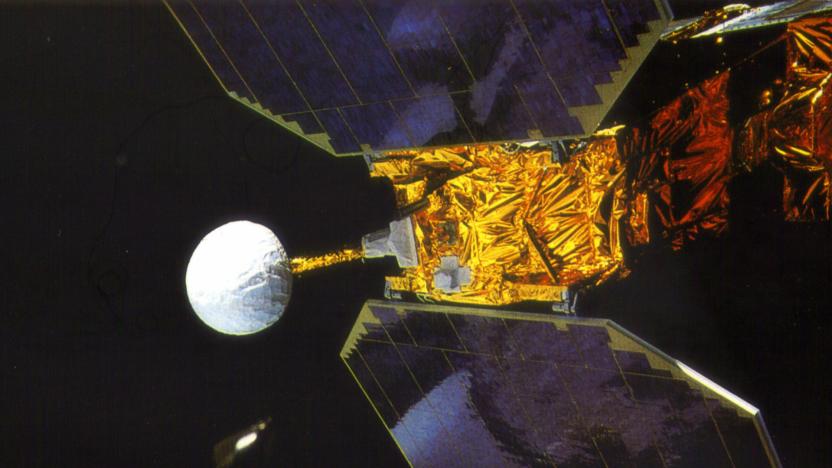space debris
Latest

NASA's 38-year-old science satellite falls safely to Earth
NASA's dead 38-year-old satellite has plunged safely through the atmosphere — but you might not see many repeats in the future.

FCC votes to boost manufacturing in space
The FCC has voted to support in-space manufacturing — this could help produce satellites and stations in orbit.

New space radar in Costa Rica can track even tiny orbital debris
There's a new giant space radar in Costa Rica that can track orbital debris as small as two centimeters.

We're entombing the Earth in an impenetrable shell of dead satellites
A recent study suggests that there is now nowhere on Earth free from the light pollution produced by overhead debris and satellites. Researchers expect that problem to only get worse as mega-constellations of internet-beaming mini-satellites, like SpaceX’s Starlink program, take off.

Legal questions linger as governments and companies keep pushing into space
The Perseverance rover’s landing on Mars is still fresh in people’s memories, privately-owned companies are ferrying people and supplies into orbit, and NASA continues to work on “the most powerful rocket” it has ever built. But as world governments and private enterprises continue to eye the skies for opportunities, a SXSW panel called “Who on Earth should govern Space” makes clear that the world’s laws dealing with space aren’t evolving as fast as the technology that gets us there.

Real life 'Pac-Man' satellite will clean up space junk
The Swiss aren't big on littering, and that philosophy apparently applies to space, too. After the nation's EPFL Center for Space Engineering launched its first satellites (the tiny SwissCubes) into orbit, the very next mission planned was "CleanSpace One" to get them out of orbit. For one, the researchers didn't want to add to the reams of existing space garbage threatening other satellites and astronauts at speeds of up to 15,000mph. But mainly, they want to test a practical system for cleaning space junk with relatively small targets. After considering various systems, the EPFL has settled on a "Pac-Man" solution that will trap the satellites with a conical net.

UK engineers developing harpoon that could help space junk meet a fiery end
Sure, we can pull space junk out of orbit with lasers or use it to cobble together new satellites, but if engineers at space firm Astrium UK have their way, space trash could be disposed of with the help of harpoons. Currently in a conceptual stage, the system is designed to shoot defunct satellites or other debris with a harpoon mounted on a "chaser satellite" and use a tethered propulsion pack to send the rubbish in an atmospheric descent where it'll burn up. Since the projectile could shoot straight through targets and result in even more garbage, it's been fashioned with a crushable portion to reduce its speed upon impact. There's no concrete word on when the outfit's solution might be put in action, but they'll present their work on Wednesday at the 63rd International Astronautical Congress in Naples (Italy, not Florida, mind you). If you can't wait to see the harpoon at work, head past the break to catch tests of an Earth-based prototype.

DARPA's new Space Surveillance Telescope will keep our satellites safe from interstellar debris
What's that in the sky? A bird? A plane? Oh, it's just some junk floating around in space, posing major threats to our military's spy satellites. To help keep an eye on it, engineers at DARPA, MIT and the Air Force have unleashed a new $110 million telescope that's been in the works for nine years now. The new Space Surveillance Telescope (SST) is capable of delivering wide-angle views of the Earth's firmament thanks to a curved CCD. This allows for a massive 3.5m aperture and f/1.0 exposure settings, capturing more light in a day that your average scope can in a week. As part of the Air Force's Space Surveillance Network (SSN), the telescope's primary task will be to look out for any microsatellites, meteors or other alien droppings moving at the same speed at which the Earth rotates. The system developed its first images earlier this year and the Air Force may eventually place SSTs all over the world, creating a 360-degree surveillance blanket and going a long way toward keeping our spycraft warm, cozy, and safe from galactic hazards.

In lasers we trust: NASA researches 5kW galactic trash disposal system
Space junk is a growing problem -- 200,000 pieces and counting -- and as the amount of earth's orbital debris increases, so does the chance some satellite will be involved in a cosmic collision. As this would cause much gnashing of teeth and woe for the affected terrestrial parties, some researchers from NASA's Ames Research Center have pitched the idea of moving said junk with a laser -- once again proving that everything's better with lasers. The idea is to use a 5kW ray, likely similar to the one we've got at the Starfire Optical Range, to slow our galactic garbage -- perhaps slowing it down enough to burn it up in earth's atmosphere. Current estimates say such a laser could migrate ten pieces of junk a day, which gives us the promise of a future with neat and tidy skies.

Australians develop space junk laser tracking system, still can't track space jams
Australian company Electric Optic Systems has announced its developed a laser tracking system which will be able to stop space junk -- discarded debris in orbit around the earth, of which there is currently over 200,000 pieces larger than 1cm -- from colliding with satellites and spacecraft. The new laser system is more precise than previous radars specifically because of its ability to track debris that is small, which can still cause major problems if encountered. Using a 3.5 million dollar grant from the Australian government, the company developed the system which it says will ultimately work best as a network.

The Professor: GM's new old engine tech, moon mirrors, the dangers of space war debris
The Professor rounds up a handful of interesting and informative gadget-related science stories from the week and presents them in an easily digestible liquid form. Having trouble keeping your fingers, thumbs, or eyeballs on the pulse of modern science? Do you find yourself in the throes of panic due to misunderstandings in molecular goings-on? Did the latest aircar, split atom, or robotic insectoid go buzzing over your head before you had time to ready a response? Don't worry friends, The Professor is here to help. Though not an actual scientist, professor, or even a college graduate, he can help guide you through the cascading, complicated, and spasmodic visionary vistas of human invention and achievement as smoothly as a hot knife descending into softened butter.







